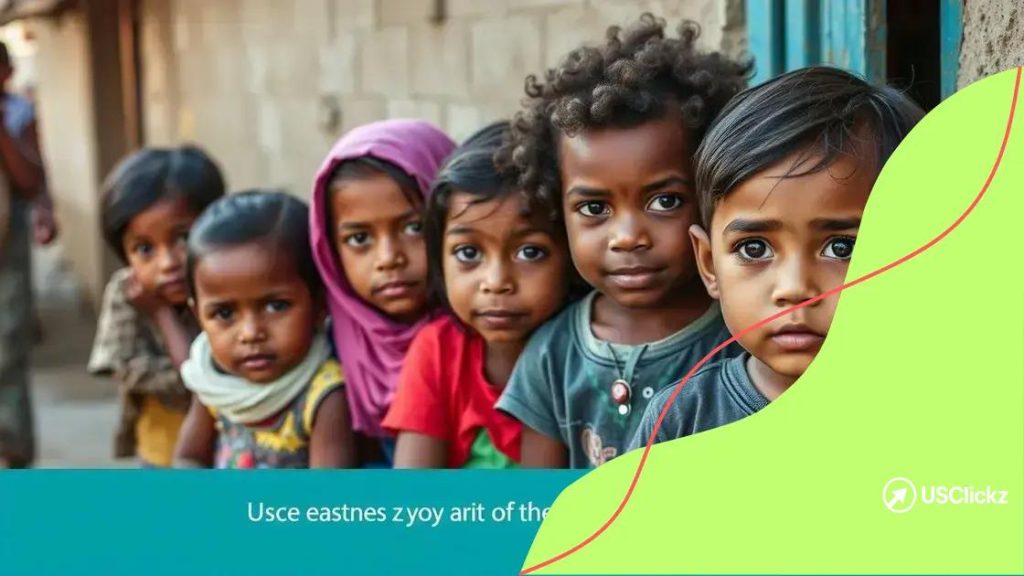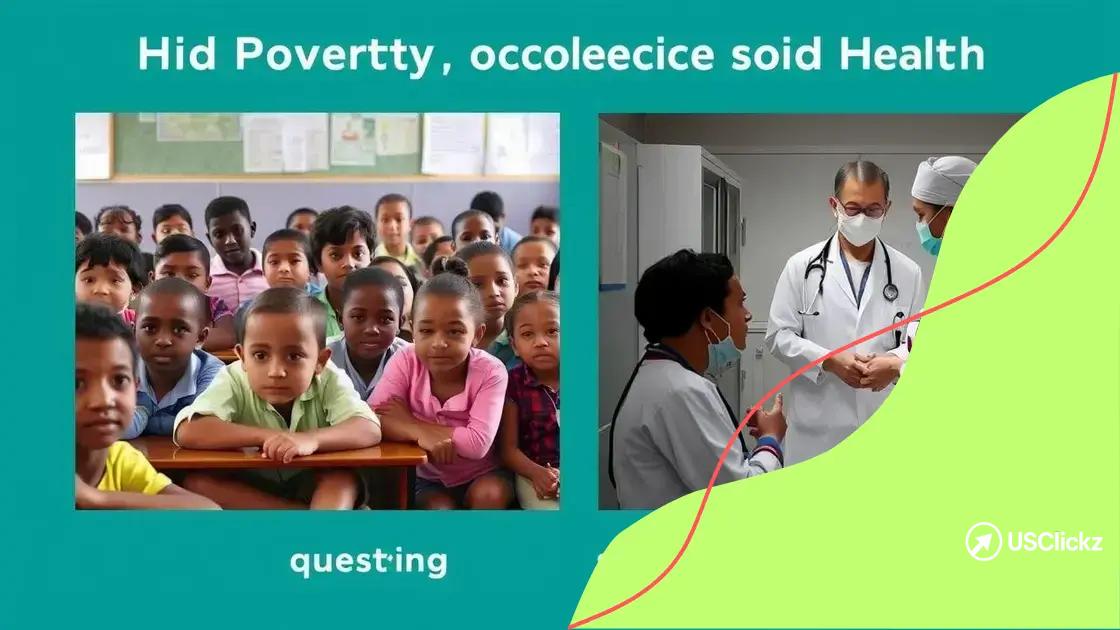Child poverty news: insights into a growing crisis

Anúncios
Child poverty results from economic instability, educational inequality, and social factors, significantly affecting children’s education and health, necessitating community support and effective policy interventions to break the cycle of poverty.
Child poverty news has become increasingly critical as more families face economic challenges. How does this issue affect our communities and what can we do to help? Let’s dive in.
Understanding child poverty: definitions and statistics
Understanding child poverty is essential to addressing the issue effectively. It defines a condition where children live in families facing significant financial hardships. This situation impacts their development and opportunities for a better future. Let’s explore the definitions and key statistics that shed light on this crucial topic.
What is Child Poverty?
Child poverty occurs when families lack the resources to meet basic needs such as food, shelter, and education. The consequences of living in poverty can be profound, affecting children’s health, education, and overall well-being. It’s crucial to recognize that poverty is not simply about a lack of money but involves constraints on access to opportunities and essential services.
Statistics on Child Poverty
Recent data indicates alarming trends regarding child poverty. Globally, millions of children live in poverty, and this crisis spans across various regions and demographics. Understanding these statistics can help us comprehend the scale of the problem.
- In the United States, nearly 1 in 6 children live in families with incomes below the federal poverty line.
- According to UNICEF, around 356 million children worldwide are living in extreme poverty.
- The COVID-19 pandemic has intensified existing disparities, with an estimated additional 100 million children pushed into extreme poverty.
These statistics highlight the urgent need for attention and action. Addressing child poverty requires collaboration between communities, governments, and organizations focused on creating sustainable solutions. By working together, we can ensure that children have access to the resources they need to thrive.
The root causes of child poverty
The root causes of child poverty are complex and multifaceted, impacting millions of children worldwide. Understanding these causes is essential for developing effective solutions. Various factors contribute to this crisis, and it is crucial to address them comprehensively.
Economic Factors
One of the leading causes of child poverty is economic instability. Families may struggle due to job loss, low wages, or lack of available employment. Economic downturns can significantly increase poverty rates, leaving children vulnerable and without essential resources.
Education Inequality
Education plays a vital role in breaking the cycle of poverty. Children from impoverished families often have limited access to quality education, which affects their future prospects. Poor educational outcomes can lead to lower-paying jobs, perpetuating the cycle of child poverty for generations.
- Schools in low-income areas frequently lack sufficient funding.
- Many children do not receive adequate support at home due to parental stress.
- Access to early childhood education programs is often limited.
These challenges illustrate how education inequality directly contributes to ongoing issues with child poverty. Addressing these concerns is crucial for creating a more equitable future.
Social Factors
Social issues, including family structure, community resources, and systemic discrimination, also contribute to child poverty. Children who grow up in single-parent households are more likely to experience poverty. Additionally, communities with limited resources struggle to provide adequate support.
- Access to healthcare is often less available in impoverished areas.
- Systemic issues can perpetuate cycles of disadvantage.
- Children may face stigma for being from low-income families.
Recognizing and addressing these social factors can help create strategies to combat child poverty effectively. By tackling the root causes of poverty, communities can work towards sustainable solutions that uplift families and support children’s growth.
Impact of child poverty on education and health

The impact of child poverty on education and health is profound and far-reaching. Children living in poverty often face numerous obstacles that hinder their development and success. These challenges can have lasting effects not only on their current lives but also on their futures.
Effects on Education
Education is a key area where child poverty plays a significant role. Children from low-income families are less likely to succeed academically. They may struggle to concentrate in school due to stress related to their home environment. Moreover, many come to school hungry or malnourished, which affects their ability to learn and retain information.
- Access to quality educational resources is often limited for low-income families.
- Students in poverty are more likely to miss school due to health issues.
- Extracurricular opportunities that enhance learning are frequently out of reach.
This lack of support can lead to lower test scores and increased dropout rates among children from impoverished backgrounds. Without proper education, the cycle of poverty continues to impact generations.
Impact on Health
The effects of child poverty extend beyond the classroom. Health outcomes for children in poverty are often dire. These children generally have limited access to healthcare services, resulting in untreated illnesses and chronic conditions. Poor nutrition is another significant issue; many children do not receive balanced meals, leading to malnutrition or obesity.
- Physical and mental health issues are more common among children in poverty.
- Access to preventative healthcare is often insufficient.
- Stress and trauma from living in poverty can harm a child’s mental health.
These health challenges can further hinder educational attainment, creating a vicious cycle that is hard to break. Addressing the impact of child poverty on education and health is essential for creating a brighter future for these children and society as a whole.
Community responses to child poverty
Community responses to child poverty play a crucial role in addressing this pressing issue. Various initiatives aim to support families and improve the overall well-being of children facing economic hardships. Collaboration among community members, organizations, and government entities is essential for creating impactful solutions.
Local Programs and Services
Many communities have developed programs specifically designed to combat the effects of child poverty. These programs provide essential resources such as food, education, and healthcare access. Local food banks, tutoring centers, and health clinics are vital in helping families overcome challenges.
- Food assistance programs help ensure children have access to nutritious meals.
- Tutoring and after-school programs support academic achievement.
- Healthcare services offer preventive care and treatment for illness.
These services are crucial in providing the necessary support that families need to thrive. They help break the cycle of poverty and empower children to achieve their potential.
Community Engagement and Advocacy
Community engagement is another critical aspect of addressing child poverty. Advocacy groups work tirelessly to raise awareness about the challenges faced by children in poverty. They organize events and campaigns to educate the public and influence policymakers.
- Grassroots movements provide platforms for affected families to share their stories.
- Community forums invite discussions on local solutions and strategies.
- Partnerships with local businesses can strengthen resources and support.
By bringing attention to the issue, communities can work together to drive change and ensure that children receive the support they need. The collective efforts of everyone involved are vital to creating lasting impacts on child poverty.
Policy recommendations to address child poverty
Policy recommendations to address child poverty are essential in creating a framework that supports families and promotes equity. These strategies aim to improve the quality of life for children living in low-income households. By implementing effective policies, communities can help break the cycle of poverty.
Strengthening Welfare Programs
One critical recommendation is to strengthen existing welfare programs. Programs such as Temporary Assistance for Needy Families (TANF) and Supplemental Nutrition Assistance Program (SNAP) provide vital resources for families. Ensuring that these programs are adequately funded can help families meet their basic needs.
- Increasing benefits can provide more substantial support for families in need.
- Expanding eligibility can help more families access these essential resources.
- Streamlining application processes makes it easier for families to receive assistance.
Such measures are crucial for alleviating the immediate pressures faced by families living in child poverty.
Enhancing Educational Opportunities
Investing in education is another vital recommendation. Access to quality education is foundational for breaking the cycle of child poverty. Policymakers should focus on funding for schools in low-income areas to improve resources and facilities.
- Implementing early childhood education programs ensures that children are prepared for school.
- Providing training and resources for teachers in underserved areas can enhance educational outcomes.
- Expanding after-school and enrichment programs helps support children’s learning outside regular school hours.
By prioritizing education, communities can create a brighter future for children affected by poverty.
Creating Job Opportunities
Another essential policy recommendation is to create job opportunities for parents. A solid job market can help families achieve financial stability. Programs that focus on job training and placement can empower parents to secure better employment.
- Developing vocational training programs provides essential skills for in-demand jobs.
- Supporting small businesses can lead to local job creation.
- Increasing the minimum wage can help lift families out of poverty.
By addressing parental employment, communities lay the groundwork for sustainable improvements in children’s lives.
FAQ – Frequently Asked Questions about Child Poverty
What are the main causes of child poverty?
The main causes of child poverty include economic instability, educational inequality, and social factors like family structure and health access.
How does child poverty affect education?
Child poverty negatively impacts education by limiting access to resources and support, leading to lower academic achievement and higher dropout rates.
What community actions can help reduce child poverty?
Community actions like food assistance programs, tutoring, and advocacy campaigns can effectively support families and raise awareness about the issue.
What policies can be implemented to address child poverty?
Policies that strengthen welfare programs, enhance educational opportunities, and create job training initiatives are essential to combat child poverty.